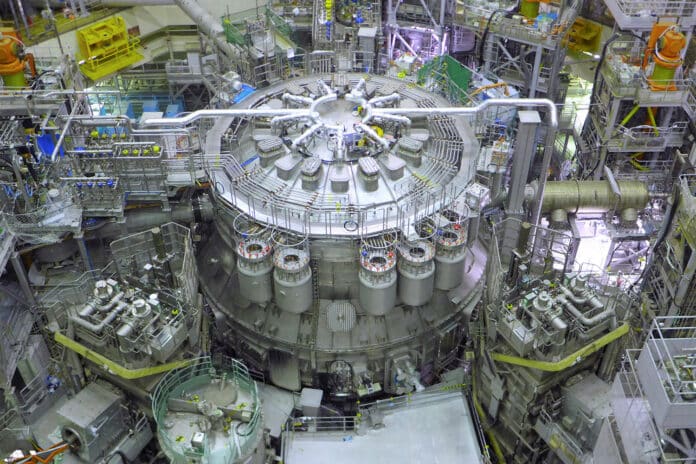JT-60SA, the world’s biggest and most advanced tokamak-type fusion reactor to date, started its official operations in Japan’s Ibaraki Prefecture.
JT-60SA is a joint international fusion experiment being built and operated by Japan and Europe in Naka, Japan, using the infrastructure of the previous JT-60 Upgrade experiment alongside new hardware.
Located roughly 85 miles north of Tokyo, the JT-60SA is a six-story-high tokamak facility that houses a circular, magnetically insulated reactor. It is designed to hold a plasma heated to 200 million degrees Celsius (around 360 million Fahrenheit) for about 100 seconds, much longer than previous large-scale tokamaks.
Although the facility was first powered up during a test run in October, the partner governments officially announced the start of operations on December 1. This marks the beginning of the world’s largest fusion center and reaffirms long-standing cooperation in the field of fusion energy.
Scientists have been working towards achieving sustainable green energy production for decades, and the tokamak has been a major part of this effort. The tokamak, which stands for “toroidal chamber with magnetic coils,” is a doughnut-shaped chamber where fusion reactions take place. Magnetic fields are used to confine the extremely hot plasma.
The tokamak is filled with gaseous hydrogen fuel that is spun at extremely high speeds using powerful magnetic coil encasements. If everything goes as planned, the ionization of atoms produces helium plasma, similar to how the sun produces its energy. This game-changing tech can produce large amounts of clean energy to meet global needs.
During the inauguration ceremony, the European Commission for Energy mentioned that the EU and Japan expressed their support for the operation and technical upgrades of JT-60SA to continue producing groundbreaking research results. The results would be useful for the International Thermonuclear Experimental Reactor (ITER) and for designing and constructing the fusion reactors of the future.
The press release about the inauguration mentions that “there was also a joint commitment to strengthen the JT-60SA International Fusion School (JIFS), successfully inaugurated in September 2023, to train young scientists and engineers and develop human resources necessary to achieve fusion energy in the future.”
The project, along with its still-in-construction sibling ITER in Europe, is intended solely to demonstrate the feasibility of scalable fusion.
Current estimates suggest that ITER will become operational sometime in 2025, although the project has faced financial, logistical, and construction issues since its groundbreaking back in 2011.
Fusion energy is a crucial technology in the journey towards achieving net zero emissions. Unlike other energy sources, the production of fusion energy does not result in carbon dioxide emissions.
Additionally, the fusion reaction is inherently safe and stops automatically when the fuel supply or power source is shut down. Furthermore, it does not generate any high-level, long-lived radioactive waste. These unique characteristics make fusion one of the most promising next-generation energy sources that can address both energy supply and environmental challenges.
